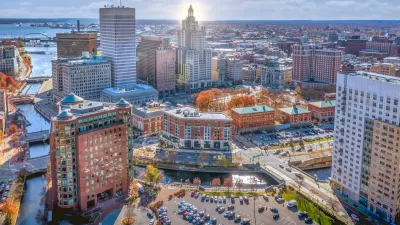Providence, Rhode Island, is rebranding itself as the "Creative Capital." This op-ed argues the city doesn't need a brand, rather it needs to return to the aesthetic values that made it beautiful and successful in the '90s.
"Last week, Mayor Cicilline branded (or rebranded) his city with a P. The logo comes with a new slogan that replaces "The Renaissance City" with "The Creative Capital." A city brands itself to try to sell its preferred image of itself to outsiders. Providence has branded itself as creative for decades. The "Renaissance City" motto, adopted in the flush of sister cityhood with Florence, the advent of gondolas on its new, Venetian-style "canals," WaterFire, AS220, etc., was such an attempt. Arguably, it worked."
"So branding a city is not necessarily ridiculous. A brand should play off of existing impressions of a place. That invites the question of the chicken or the egg, of course. But in branding itself, a city should above all avoid shooting itself in the foot."
"In the 1990s, Providence was transformed into the Venice of New England. New traditional buildings strengthened the city's grand architectural heritage - its powerful brand, three centuries old. This put Providence on a path to creating a new district, Capital Center, unique in the annals of American urban planning. But then, in the early 2000s, the city did a U-turn. Ugly modernist buildings rose to snatch defeat from the jaws of victory. This false creativity led to an entirely predictable hodgepodge of the old and the new, indistinguishable from that of most U.S. cities. In short, Providence has spent much of the decade shooting its excellent brand in the foot."
FULL STORY: David Brussat: Rebranding Fort Providence

Planetizen Federal Action Tracker
A weekly monitor of how Trump’s orders and actions are impacting planners and planning in America.

San Francisco's School District Spent $105M To Build Affordable Housing for Teachers — And That's Just the Beginning
SFUSD joins a growing list of school districts using their land holdings to address housing affordability challenges faced by their own employees.

The Tiny, Adorable $7,000 Car Turning Japan Onto EVs
The single seat Mibot charges from a regular plug as quickly as an iPad, and is about half the price of an average EV.

San Diego Votes to Rein in “Towering” ADUs
City council voted to limit the number of units in accessory buildings to six — after confronting backyard developments of up to 100 units behind a single family home.

Texas Legislature’s Surprising Pro-Housing Swing
Smaller homes on smaller lots, office to apartment conversions, and 40% less say for NIMBYs, vote state lawmakers.

Even Edmonton Wants Single Staircase Buildings
Canada's second most affordable major city joins those angling to nix the requirement for two staircases in multi-family buildings.
Urban Design for Planners 1: Software Tools
This six-course series explores essential urban design concepts using open source software and equips planners with the tools they need to participate fully in the urban design process.
Planning for Universal Design
Learn the tools for implementing Universal Design in planning regulations.
Borough of Carlisle
Smith Gee Studio
City of Camden Redevelopment Agency
City of Astoria
Transportation Research & Education Center (TREC) at Portland State University
City of Camden Redevelopment Agency
Municipality of Princeton (NJ)





























